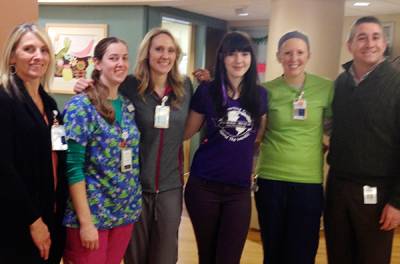-
{care_team_members status="Open|hide from care team page"}
-

{care_team_members:ct_first_name} {care_team_members:ct_last_name}
{care_team_members:ct_full_title}
{/care_team_members}
person:channel_short_name: {person:channel_short_name}
person:
title: {person:title}
-
{links}
{/links}
No category selected to display locations. Locations Dynamic
-
{locations}
- {locations:title} {/locations}
-
{widget}
{widget:widget_content}
- {widget:widget_content:tab_title} {/widget:widget_content} {/widget}
When Cassidy Megan was 8-years-old she called the prime minister of Canada and was frustrated when his assistant would not let her speak directly to Stephen Harper. Cassidy needed to talk to him because she wanted Harper and members of Parliament to wear purple. She had a good reason.
It was 2008 and Cassidy, living in Nova Scotia, was newly diagnosed with epilepsy—a neurological disorder associated with abnormal electrical activity in the brain. Epilepsy is diagnosed when a person has two or more unprovoked seizures. The seizures can range from mild to severe and can include “zoning out,” loss of consciousness, or repetitive and involuntary jerking movements.
 Cassidy says the diagnosis left her feeling sad and isolated. She felt like she was the only person dealing with memory and concentration issues, a loss of independence, and a disease not well understood by her friends. “Some kids told me their parents didn’t want them to play with me because they were afraid of ‘catching’ epilepsy,” Cassidy reports. It was a difficult time.
Cassidy says the diagnosis left her feeling sad and isolated. She felt like she was the only person dealing with memory and concentration issues, a loss of independence, and a disease not well understood by her friends. “Some kids told me their parents didn’t want them to play with me because they were afraid of ‘catching’ epilepsy,” Cassidy reports. It was a difficult time.
Cassidy’s mother, Angela McCarthy, says the family’s motto helped them through the darkness. “I tell my kids, you can throw yourself a pity party, but you can’t stay there,” McCarthy says with a laugh.
Cassidy channeled her energy into a campaign. She emailed every member of the Canadian Parliament and started a Facebook group to declare March 26 as Purple Day.
“I want people who have epilepsy to realize they’re not alone. I also want to educate people about epilepsy. That was my main goal at first. Then I wanted to go global,” Cassidy says.
Cassidy’s mother thought her daughter’s ambition was admirable but probably unattainable. “I was a bit surprised that she wanted Purple Day to be a worldwide movement,” McCarthy says. “I just patted her on the arm that first year and said, let’s see if we can get our neighbors to join us first. Then, maybe, we can take on the world.”
Cassidy’s persistence paid off and in 2009 the Epilepsy Association of Nova Scotia joined forces with the New York-based Anita Kaufmann Foundation to launch Purple Day internationally. Today, more than 100 countries participate in Purple Day.
Cassidy is now 18 and preparing to graduate from high school. She was a leader at the recent 3rd Annual Purple Day Walk for Epilepsy at the Mall of America. Cassidy was also part of an attempt to break the Guinness World Record for the largest seizure first aid session ever.
During their visit to the Twin Cities, Cassidy and her mother toured Gillette Children's. Gillette has one of the nation’s premier teams of pediatric neurologists and neurosurgeons who work together on treatment plans for people who have epilepsy and other neurological conditions.
 “We tour children’s hospitals all over the world and we’re super impressed by Gillette,” McCarthy says. “We’ve been in Minnesota twice before for the Purple Day Walk. I have to say, Gillette is more impressive than the Mall of America!”
“We tour children’s hospitals all over the world and we’re super impressed by Gillette,” McCarthy says. “We’ve been in Minnesota twice before for the Purple Day Walk. I have to say, Gillette is more impressive than the Mall of America!”
Cassidy agrees. “I can’t believe how cheerful and bright the rooms are at Gillette. Everyone is hopeful and so kind to all the kids. I’m very impressed. I wish Gillette was closer to Nova Scotia because it would make it easier for me to visit and hang out with the kids.”



